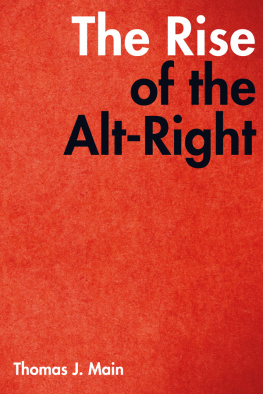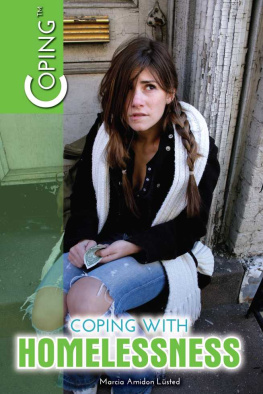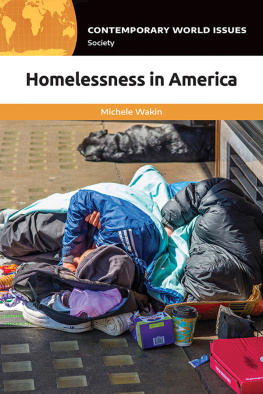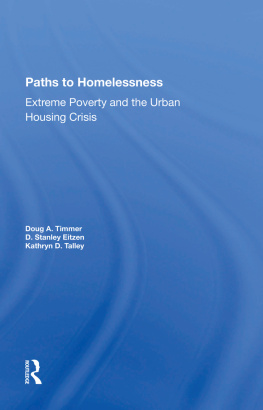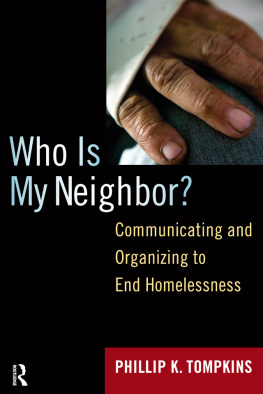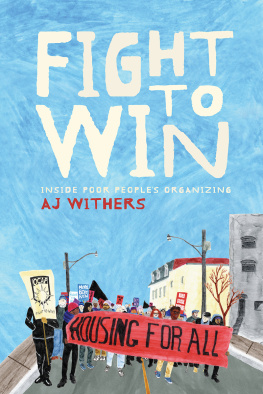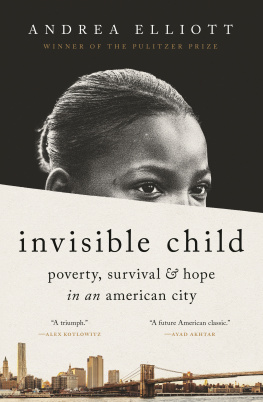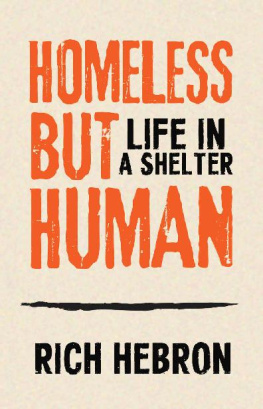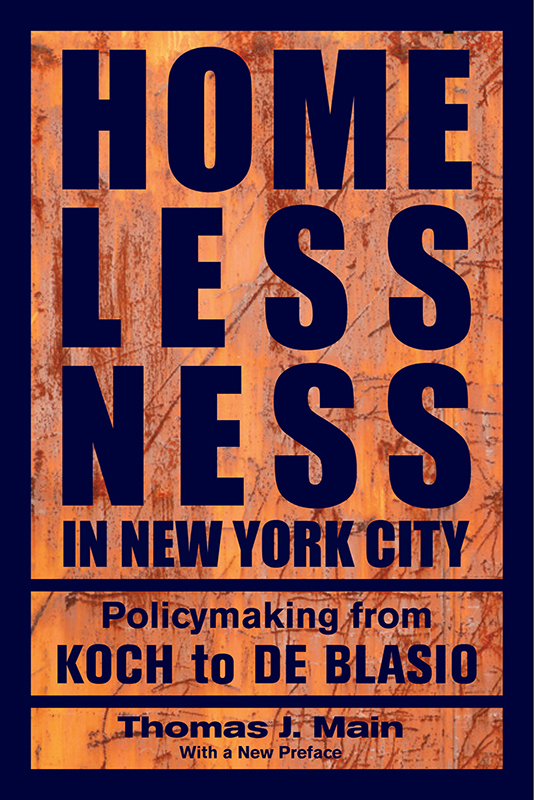
Homelessness in New York City
Homelessness in New York City
Policymaking from Koch to de Blasio
Thomas J. Main

NEW YORK UNIVERSITY PRESS
New York
NEW YORK UNIVERSITY PRESS
New York
www.nyupress.org
2016 by New York University
All rights reserved
First published in paperback in 2017.
References to Internet websites (URLs) were accurate at the time of writing. Neither the author nor New York University Press is responsible for URLs that may have expired or changed since the manuscript was prepared.
Library of Congress Cataloging-in-Publication Data
Names: Main, Thomas James, 1955- author.
Title: Homelessness in New York City : policymaking from Koch to De Blasio / Thomas J. Main.
Description: New York : New York University, [2016] | Includes bibliographical references and index.
Identifiers: LCCN 2016010259| ISBN 9781479896479 (cl : alk. paper) | ISBN 9781479846870 (pb : alk. paper)
Subjects: LCSH : HomelessnessGovernment policyNew York (State)New York. | HomelessnessNew York (State)New YorkHistory. | Public welfare
New York (State)New YorkHistory.
Classification: LCC HV4506.N6 M35 2016 | DDC 362.5/92561097471dc23
LC record available at https://lccn.loc.gov/2016010259
New York University Press books are printed on acid-free paper, and their binding materials are chosen for strength and durability. We strive to use environmentally responsible suppliers and materials to the greatest extent possible in publishing our books.
Manufactured in the United States of America
10 9 8 7 6 5 4 3 2 1
Also available as an ebook
To my wife, Carla Main
Contents
I wish to thank the following people for assistance that made this book possible. Lawrence M. Mead of New York University has been my friend and colleague for many years and provided me with invaluable criticism and inspiration. The School of Public Affairs at Baruch College, City University of New York, my professional home for more than twenty years, has been a supportive community throughout; colleagues at the school who have been especially supportive include Sanders D. Korenman, Dahlia Remler, Jerry Mitchell, James A. Krauskopf, and David S. Birdsell. Lawrence M. Mead, Nicole P. Marwell, Neil J. Sullivan, and Daniel W. Williams read early drafts of the book and provided valuable advice. Two anonymous reviewers for NYU Press also made useful suggestions. Any remaining errors or omissions are my own. Kardi Teknomo of the School of Science and Engineering, Ateneo de Manila University, Philippines, did the queuing theory analysis that appears in chapter 3, table 3.1, concerning the debate over the Callahan consent decree plumbing ratios. Clara Platter and Constance Grady were wonderful editors. Benjamin Gillespie did a great job putting the books tables and charts into order, and Diana Lazov helped me prepare the final manuscript file. My wife, Carla Main, endured my long process of writing this book and provided wise counsel and indispensable inspiration. My sons, Henry Main and Joshua Main, my brother, William Main, and my cousin, Margaret Gallacher, kept my spirits up. To my parents, George Main and Catherine Main, and my grandmother, Catherine Gallacher, who raised me, I owe greater thanks than I can express here. Finally, I would like to acknowledge the importance of the people who have been homeless in New York City over the past thirty-five years and express my admiration for all the actors who have worked to improve their lot.
This book contains excerpts from the following articles that I have previously written: Quantum Change in the Fragmented Metropolis: Political Environment and Homeless Policy in New York City, Review of Policy Research 23, no. 4 (2006); Shelters for the Homeless Men in New York City: Toward Paternalism through Privatization, in Lawrence M. Mead, ed., The New Paternalism (Washington, DC: Brookings Institution Press, 1997); Hard Lessons about Homelessness: The Education of David Dinkins, City Journal, Summer 1993; The Homeless of New York, Public Interest no. 72 (Spring 1983).
Homeless Policy under de Blasio
Thomas J. Main and Peter Nasaw
During the course of his overwhelmingly successful campaign for mayor, Bill de Blasio made poverty and income inequality his main issues. As the liberal journalist and fervent de Blasio supporter Eric Alterman put the matter, De Blasio made economic inequality the central issue in his campaign and attempted to tie nearly every issue he addressed to that problem. Homelessness was obviously such an issue, and so when de Blasio took office in January 2014, expectations were high that he would address that problem effectively.
Unfortunately, as of April 2017, under the new mayor, the homelessness problem had, by several important measures, gotten worse. The month de Blasio assumed office there were 53,615 people in the Department of Homeless Services (DHS) shelter system. That number has hovered around sixty thousand people since December 2014. The annual enumeration of street dwellersthe HOPE countis down from 3,537 people in 2014 to about 2,794 in 2016, which is a positive trend but not a dramatic improvement. And the DHS budget remains high: $1.29 billion for fiscal year 2017.
Voters and other observers are not impressed. Quite surprisingly, given the emphasis de Blasio put on poverty and homelessness in his campaign, a March 2017 Quinnipiac University poll found that voters rated this the weakest aspect of the mayors performance, with 55 percent disapproving. And the New York Times, which supported de Blasios mayoral run, recently concluded, The rise in homelessness is arguably the mayors biggest failure in that goal to close the gap between the haves and the have-nots. How did the mayor end up in this position, and what is he doing about it?
To put de Blasios situation in context, we have to back up to 2004, when Mayor Bloomberg developed a five-year plan to make the condition of chronic homelessness effectively extinct in New York. Bloomberg pledged to reduce the shelter census36,399 people in June of 2004by two-thirds in five years, to about 12,000 persons by 2009.
On October 19, 2004, DHS abandoned its long-term policy of giving shelter residents priority for entering public housing and for federal Section 8 rent vouchers. Commissioner of DHS Linda Gibbs believed that moving one shelter family to public housing would draw at least one new family into the system. But economists found that to draw one family into the system requires placing seven families into subsidized housing. Perverse incentives are real but too weak to drive up the shelter census. Nonetheless, shelter families lost preferential access to public housing and Section 8 vouchers; instead, they were eligible for a temporary five-year rent subsidy, Housing Stability Plus, replaced in 2007 by the Advantage two-year-maximum rent-subsidy program, which was funded jointly by the state and the city.
By Bloombergs deadline of June 2009, the shelter census had not dropped appreciably. Then, as a result of a falling out between the city and the state over funding, Advantage ended. At that point no subsidies of any kind were offered to move families out of the shelter system. The number of people in the DHS shelter system began going up, and in January 2014 de Blasio inherited a record high shelter census. De Blasios challenge was to create a new rent subsidy, implement it effectively, and hang on until it took hold. How well did he meet that challenge?
Next page

